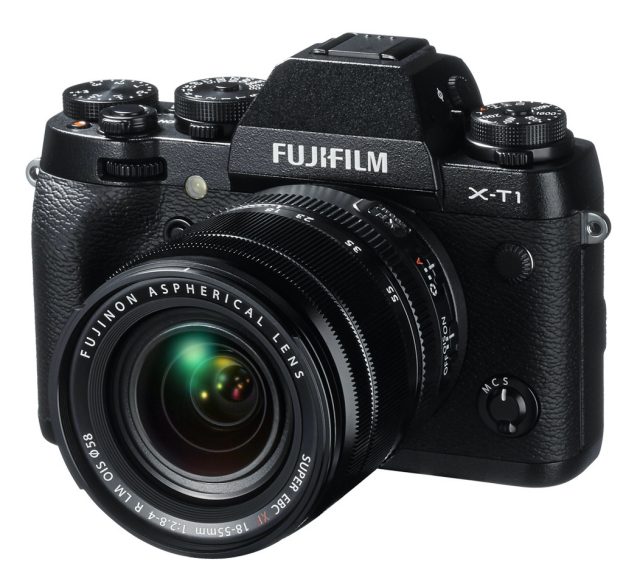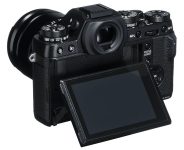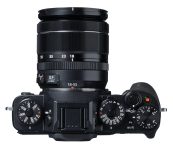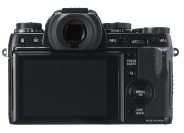Announced
Production status
System
Fujifilm X system cameras
- Fujifilm X-A1
- Fujifilm X-A10
- Fujifilm X-A2
- Fujifilm X-A20
- Fujifilm X-A3
- Fujifilm X-A5
- Fujifilm X-A7
- Fujifilm X-E1
- Fujifilm X-E2
- Fujifilm X-E2S
- Fujifilm X-E3
- Fujifilm X-E4
- Fujifilm X-H1
- Fujifilm X-H2
- Fujifilm X-H2S
- Fujifilm X-M1
- Fujifilm X-Pro1
- Fujifilm X-Pro2
- Fujifilm X-Pro2 Graphite Edition
- Fujifilm X-Pro3
- Fujifilm X-S10
- Fujifilm X-S20
- Fujifilm X-T1
- Fujifilm X-T1 Graphite Silver Edition
- Fujifilm X-T10
- Fujifilm X-T100
- Fujifilm X-T2
- Fujifilm X-T2 Graphite Silver Edition
- Fujifilm X-T20
- Fujifilm X-T200
- Fujifilm X-T3
- Fujifilm X-T30
- Fujifilm X-T30 II
- Fujifilm X-T4
- Fujifilm X-T5
- Fujifilm X-T50
Fujifilm X-T1
APS-C AF digital mirrorless camera • Discontinued
Specification
| Format: | |
| APS-C | |
Imaging sensor: | 23.6 × 15.6mm X-Trans CMOS II sensor |
Resolution: | 4896 × 3264 - 16 MP |
Crop factor: | 1.53x |
Sensor-shift image stabilization: | - |
| Fujifilm X [17.7mm] | |
| Shutter: | |
Type: | Focal-plane |
Model: | Electronically controlled |
Speeds: | 30 - 1/4000 + B |
| Exposure: | |
Exposure metering: | Through-the-lens (TTL), open-aperture |
Exposure modes: | Programmed Auto |
| Aperture-priority Auto | |
| Shutter-priority Auto | |
| Manual | |
| Physical characteristics: | |
Weight: | 440g |
Dimensions: | 129x89.8x46.7mm |
Manufacturer description
Valhalla, N.Y., January 27, 2014 – As a leader in advanced digital camera technology and outstanding image resolution, FUJIFILM North America Corporation today announced the new FUJIFILM X-T1, a weather-resistant premium interchangeable lens camera with a large OLED electronic viewfinder (EVF) that delivers a near-instant image preview, the latest generation 16.3 Megapixel APS-C X-Trans CMOS II sensor and the segment’s fastest autofocus of 0.08 seconds*1 for a truly remarkable photographic experience anywhere.
The FUJIFILM X-T1 now gives professional and enthusiast photographers the award-winning imaging power of the X-Series in a water, dust and temperature resistant body that braves outdoor challenges like never before.
OLED viewfinder perfection
The FUJIFILM X-T1 combines a unique wide-angle 2.36m dot resolution OLED view with the world’s highest magnification (0.77x) for a digital camera *2 and shortest display lag-time of just 0.005sec*3 to react as quickly as you need in any environment.
The OLED viewfinder also includes cutting-edge technology to bring users even closer to their subjects. The X-T1’s viewfinder uses a newly designed Graphic User Interface that provides an exciting shooting experience with clear details and a comfortable at-a-glance view of your settings.
The X-T1 has four OLED EVF Display Modes:
- "FULL" mode takes full advantage of the high magnification ratio of the X-T1's viewfinder to give an unrivalled view of the scene
- "NORMAL" provides an optimum view, including shooting settings
- "DUAL" is specially designed for manual focusing with a clever split view. The regular view and manual focus area can be simultaneously checked (with Digital Split ImageTM or Focus Peak Highlight)*4
- “PORTRAIT” view in “NORMAL" and “FULL” modes automatically rotates the displayed information when the camera is held vertically
Award-winning 16.3 Megapixel APS-C X-Trans CMOS II sensor and EXR Processor II
The FUJIFILM X-T1 uses the award-wining EXR Processor II and X-Trans™ CMOS II sensor with built in phase detection that delivers an astonishing response time of just 0.08 seconds and a super-fast 0.5 second start-up time*5, along with a 0.05 second shutter time lag and a 0.5 second shooting interval*6.
The X-T1 can also shoot up to 8 frames per second*7 with tracking AF and is the first-ever CSC*8 to be compatible with SDXC UHS-II format memory cards for data writing speed (in Continuous Mode) that is approximately twice that of a conventional SD card.
Tough, weather-resistant design
The FUJIFILM X-T1 is the first weather-resistant X-Series CSC (when used with a weather-resistant lens) that performs in a wide range of challenging environments. The X-T1 uses more than 75 points of weather sealing, and the camera body is dust-resistant and water-resistant. The X-T1 is also freezeproof to -14°F for full-fledged field photography work, while the premium clear 3” LCD screen with 1.04 million dot resolution is made of tempered glass for additional outdoor protection.
Traditional handling, modern response
With five mechanical dials on the top-plate, two command dials; one on the front and one on the rear, and six fully customizable function buttons, the FUJIFILM X-T1 feels and functions like a proper photographic tool in the hand. The top-plate includes two machined-aluminum double-deck dials for the shutter speed and metering, and the ISO sensitivity and drive modes, and each is designed to turn with a reassuring click, while their textured surfaces gives a firm confirmation when setting up a shot.
With their exposure values clearly marked, the X-T1’s settings can be checked at a glance without using the rear LCD and the dials are perfectly arranged so that functions can be changed without removing your eye from the viewfinder. The six customizable function buttons and two command-dials arranged on the front and rear complete the picture, ensuring instant setting satisfaction.
WiFi and remote camera operation
The X-T1 one-touch WiFi connectivity lets you easily share images to your smartphone or tablet – pictures that these devices cannot capture - and remote shooting via smartphone or tablet using the Fujifilm Camera Remote app for unique capture opportunities.
Additional grip and weather resistant lenses
The optional vertical battery grip (VG-XT1) has the same hardy structure as the X-T1, so when added to the body, it is completely secured against the elements.
Fujifilm is launching three weather-resistant zoom lenses to complement the X-T1 camera in 2014, including the XF18-135mmF3.5-5.6 R OIS WR, XF16-55mmF2.8 R OIS WR and the XF50-140mmF2.8 R OIS WR.
FUJIFILM X-T1 key features list:
- 16.3 million Megapixels APS-C X-Trans CMOS II Sensor
- Dust and water-resistant body with more than 75 points of weather sealing. Freeze resistance to -14°F
- EXR Processor II
- World’s fastest AF of 0.08 seconds
- Startup time of 0.5 seconds
- Shutter time lag of 0.05 seconds
- Shooting interval of 0.5 seconds
- Phase detection AF and motion predictive AF for continuous shooting up to 8 frames per second
- High-precision 2.36 million dot OLED viewfinder
- Highest viewfinder magnification for digital cameras of 0.77x
- Wide viewing angle (diagonal 38° and horizontal 31°)
- Ultra-fast Real Time Viewfinder with a lag-time of 0.005sec (less than 1/10 of existing models)
- Four different display modes: Full, Normal, Dual and Vertical.
- Full mode: Displays shooting information at the top and bottom of the screen to avoid obstruction of the view
- Dual mode: Adds a small second screen for checking focus point with Focus Peak Highlight or Digital Split Image
- Normal mode: Lets you concentrate on framing the shot in Auto Focus mode while keeping you aware of how the shooting conditions are changing, making it the perfect setting for sports and action photography
- Portrait mode: When in Full or Normal modes, it rotates the shooting information interface when the camera is turned vertically
- Tempered glass 1.04 million dot high-precision 3” tilting LCD monitor
- Digital Split Image and Focus Highlight Peaking
- World’s first compatibility with Ultra High Speed UHS-II SD memory cards
- Vertical battery grip VG-XT1 and three new zoom lenses offer the same weather resistance to secure the entire system
- Redesigned circuit board design enables high ISO 51200 setting*9
- ISO200 - 6400, extended ISO 100, 12800, 25600, Auto(maximum ISO setting from ISO 400 – ISO6400 available)
- Lens Modulation Optimizer technology maximizes each lens’ performance
- In-camera RAW converter
- Die-cast magnesium body provides a sturdy and durable, while compact and lightweight design
- Body and grip designed for correct balance when attaching telephoto and large-diameter lenses
- Two command dials and six Function buttons for instant control and customization
- Interval timer shooting for Time Lapse photography is available with intervals of 1 second to 24 hours and up to 999 frames



